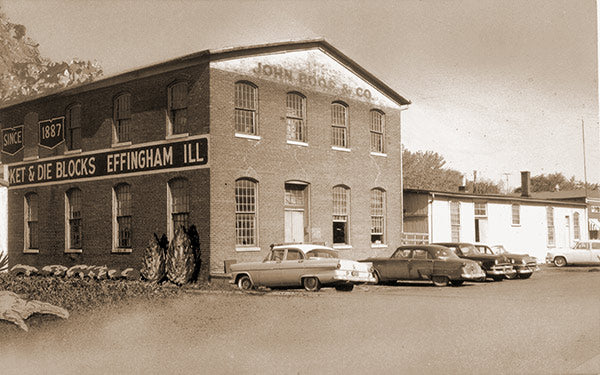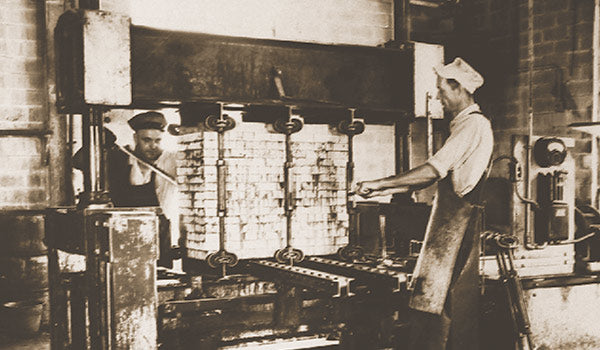Posted on November 05 2015

Original John Boos Wood Factory in Effingham
It was 1887 in Effingham, Illinois when Conrad Boos developed his first butcher block for a local blacksmith. Helping to absorb the impact of blacksmithing tools on his custom made sycamore wood slab supported on three legs, Boos might not have known in that moment how much value his work would soon have.

Local businesses took note and soon Conrad’s son John saw opportunity knocking and was fast building similar “block tables” for the local butcher, and others. John Boos & Co. was born, named after John by his father. They were one of hundreds of local wood companies around the nation, before the introduction of steam-powered travel, catering to a local need for fine wood products.
Times would soon change however, and in the later part of the century trains transformed how goods were sold. No longer limited to their 300-mile sales radius, and with the help of a very successful catalog, John Boos & Co. took the lumber world by storm, placing hard winter maple sourced in northern states, in commercial kitchens everywhere by the mid 20th century.

They were so successful in their block design, soon tobe called the Boos Block, they even sent products to the 1900 World Fair in Paris, and it didn’t take long for stateside government officials to harness the power of the company. During WWII, John Boos & Co. supplied the United States Army, Navy and Marines, with various wooden butcher blocks and counter surfaces, including those being used in massive aircraft carriers around the world at the time; John Boos & Co. were certainly taking flight.
So good were Boos wood products that in 1957 the company was brought to Sonoma, California to meet with a man by the name of Chuck Williams. John Boos & Co. would be part of the quickly developing Williams-Sonoma. With favorite celebrities like Julia Child on their side, Williams-Sonoma was set to sell goods to the everyday cook, and introduce a brand of cutting block, “The Boos Block” and boards of the highest quality, to the masses.

Modern metal plant at John Boos' headquarters in Effingham
By the 1960’s, they realized there was also a need for industrial support and complimentary furniture for their wooden blocks and counter tops. Rather than wait on the market to accommodate them, Boos & Co. began stainless steel fabrication for business kitchens, butcher shops, chain restaurants, stadiums and even church facilities. As different as wood and stainless steel are, they played a vital role working together, in kitchens around the country. “We do not differentiate for commercial and retail,” said Ted Gravenhorst Jr., Vice President of Sales and Marketing at John Boos & Co., “they’re the same product.”
Branding has become a huge part of the company’s legacy. Though the everyday home chef can find John Boos cutting boards and Boos Blocks at fine retailers, the Boos brand will not be found at non-specialty shops or big box stores. They are holding the line in butcher block fabrication for the serious chef, as well as providing practical restaurant equipment and kitchen islands and furniture.
Culinary experts have taken note of the industrial quality, as Chef Tyler Florence recently commissioned a seven-foot round block for one of his restaurants, a production so large, it will have to be pieced together once on site.

Unfortunately, this epic butcher block table is not for sale
Though the company was founded using local sycamore for their products, a laminated hard winter maple has become the favorite of chefs everywhere. It is locally sourced, sustainably grown and financially the best bet for the consumer. Maple from the northern states grows in a freeze zone, creating a harder wood with fewer pests. It is the preferred wood in commercial kitchens because of its price point, its kindness to a knife’s edges, and its germ resistant nature.
In 1995 a major shift occurred in worldwide food sanitation. Bacteria, salmonella, and food borne illnesses in general, had the consumer becoming hyper-aware of food safety, and food safety officials took aim at food preparation facilities.Suddenly wood cutting surfaces were not considered the best option for commercial kitchen use by health inspectors (though that would change again in the coming decade and hard maple would make a resurgence on the scene), the demand for polyethylene plastic boards skyrocketed.
John Boos & Co. didn’t wait for tides to shift, and began production of various plastic boards that were safe to sanitize in industrial dishwashers – something you couldn’t do to wood without ruining the product. Regardless of the shift in materials, John Boos & Co. upheld their high company expectations for the best products available.
“We’re very focused on chefs, we have been for 30 years,” noted Gravenhorst Jr. And that focus has spilled over into their production of food grade plastic cutting boards, countertops and stainless steel facility furniture and fixtures, which make up 55-60% of the company’s production line now.
In spite of the change in trends in the 1990s, wood has held its own as a quality work surface in the kitchen. The National Sanitation Foundation, or NSF, has since approved the use of certain maple boards and pecan wood for industry kitchen use. Plus, a hard winter maple board will keep your cutting tools in top shape, according to Gravenhorst Jr.
Chefs like Tyler Florence are proof of the change in mentality towards the safety of wooden cutting surfaces, and have welcomed the change in health inspector regulations, quickly bringing wood cutting boards back into mainstream kitchen use. Asked whether he sees wood making a complete rebound, Gravenhorst replied, ”Will wood ever make its way back into commercial use like it was in the 1960s? We don’t know, but we keep an open mind, and our eyes open to new possibilities.”
In the next decade John Boos & Co. plans to build a new wood plant, and to move farther into overseas markets like Europe and Asia. John Boos & Co. still hold their own as a company and a brand. Staying true to their roots, John Boos & Co. continues to grow worldwide.



